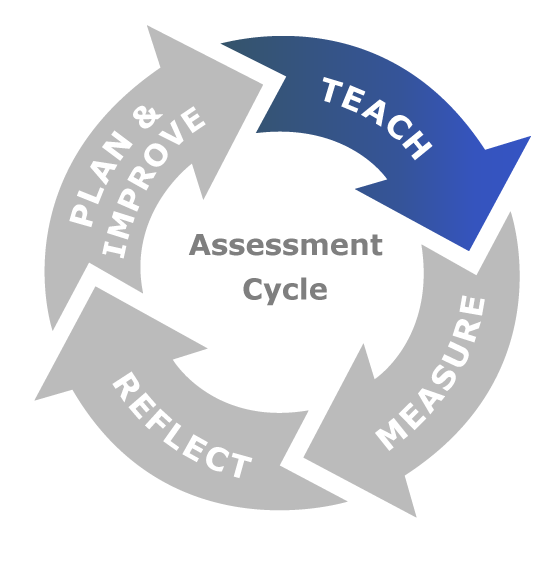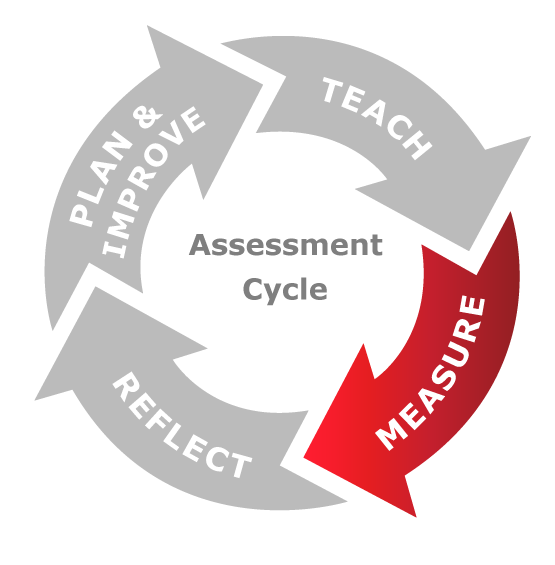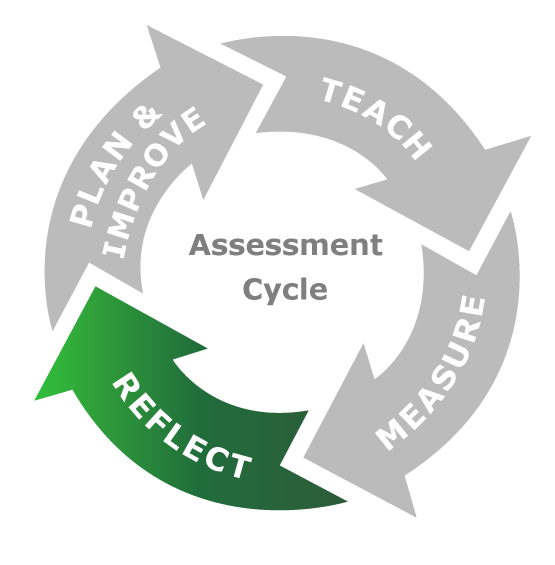The Cycle of Assessment
Good assessment follows an intentional and reflective process of design, implementation, evaluation, and revision. The Cycle of Assessment relies on four simple but dynamic words to represent this process: Teach, Measure, Reflect, and Plan & Improve.
The following graphics show how the Cycle of Assessment is built on these four distinct but interrelated actions.
Assessment Cycle: Teach
“Teaching” is the first phase of our assessment cycle. We employ strategies to help our students learn the course outcomes.

Assessment Cycle: Measure
“Assessing Student Learning” is the second phase of our assessment cycle. We develop methods to assess whether our students are learning the material.

Assessment Cycle: Reflect
“Reflecting” is the third phase of our assessment cycle. We look back on whether our teaching strategies were successful and what changes we can make improve to student learning.

Assessment Cycle: Plan & Improve
“Improving our instruction” is the fourth phase of our assessment cycle. We refine our instructional strategies and techniques to help all students achieve mastery of the course outcomes.

What do I want students to learn?*
Good assessment planning begins by identifying learning outcomes for students. Planning then involves building programs and courses that provide students opportunities to achieve these learning outcomes.
Alignment and integration of learning outcomes are the keys to successful assessment planning. Learning outcomes identified at the institutional level must be integrated at the program and course level. Conversely, course outcomes must align with program outcomes, which in turn must align with institutional outcomes.
Effective planning and integration depends on clearly articulated goals for student learning. Outcome statements must also be measurable and must target various skill levels within the cognitive domain.
The links on this page provide guidance with each of these elements of successful assessment planning. The first link discusses the paradigm shift at the heart of contemporary assessment-the shift from a focus on what the instructor does to what the student learns. The second set of links provides specific information designed to guide effective planning. The final link provides a light-hearted but helpful overview of planning components.
How do I teach effectively?*
Assessment gathers data on what students do (what is learned) not on what instructors do (what is taught). However, the “DO” stage of the assessment cycle begins with instructors and with the question, “How do I teach effectively?”
Effective teaching provides continuity between the Plan and Check stages of the assessment cycle. Effective teachers implement program outcomes at the course level in ways that facilitate student learning. That is, they design learning activities that help students achieve what is developed in the Plan stage. The range of possible learning activities is wide and varied: projects, papers, performances, presentations, and exams are the most familiar direct measurements of student learning used at the course level.
Learning activities must be designed to stimulate learning and to yield assessment data for the evaluation that follows in the Check stage. In addition to relying on data gathered within particular courses, program evaluation is also based on other sources of assessment data, including direct measures such as comprehensive and standardized exams and indirect measures such as course evaluations and alumni surveys. The development of these assessment measures is also part of the Do stage.
Are my outcomes being met?*
The previous stage concludes with students “doing” activities designed to help them achieve learning objectives developed at the “planning” stage. Effectively designed activities generate assessment data that is “checked” at this stage of the assessment cycle.
Checking should occur at both the course and program levels. Instructors check the array of activities students complete to fulfill course requirements. But if checking stops with the individual instructor, then program assessment will necessarily be limited. Effective program assessment requires that participants gather and share data on student achievement of program outcomes. Some of this data may come from assessments not limited to a particular course (such and surveys and competency exams). Other data will come from student performance within the courses that constitute the academic program.
Checking seeks to determine the extent to which students are achieving each outcome. Thus, a global measure of student success, such as a course grade, is not likely to provide sufficient assessment data. Effective course and program evaluation requires that student performance on individual outcomes be reported as specifically as possible.
How do I use what I’ve learned?*
Good instructors constantly act on the results of assessment. When students don’t seem to be achieving desired outcomes, instructors make adjustments. Such a process is continuous and includes both reinforcement and revision. The things that work, stay; the things that don’t, go.
When the above process is followed within an individual course, the assessment cycle is complete and able to repeat. Instructors can improve at each stage of the process, but the minimum requirements of assessment are being met and modifications (based on assessment data) can be made to improve student learning.
Action can be taken at the program level provided sufficient data have been gathered and checked. If the steps described in the Check stage have been followed, those involved in designing the program can take needed action.
At both the course and program levels, the results of “checking” identify “actions” that will form the basis for subsequent “planning.” Action thus allows the Plan-Do-Check-Act cycle to continue.

